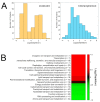The Effect of 2-Thiocyanatopyridine Derivative 11026103 on Burkholderia Cenocepacia: Resistance Mechanisms and Systemic Impact
- PMID: 31546596
- PMCID: PMC6963507
- DOI: 10.3390/antibiotics8040159
The Effect of 2-Thiocyanatopyridine Derivative 11026103 on Burkholderia Cenocepacia: Resistance Mechanisms and Systemic Impact
Abstract
Bacteria of the Burkholderia cepacia complex (Bcc) are associated with significant decline of lung functions in cystic fibrosis patients. Bcc infections are virtually impossible to eradicate due to their irresponsiveness to antibiotics. The 2-thiocyanatopyridine derivative 11026103 is a novel, synthetic compound active against Burkholderia cenocepacia. To characterize mechanisms of resistance to 11026103, B. cenocepacia was subjected to chemical mutagenesis, followed by whole genome sequencing. Parallel mutations in resistant isolates were localized in a regulatory protein of the efflux system Resistance-Nodulation-Division (RND)-9 (BCAM1948), RNA polymerase sigma factor (BCAL2462) and its cognate putative anti-sigma factor (BCAL2461). Transcriptomic analysis identified positive regulation of a major facilitator superfamily (MFS) efflux system BCAL1510-1512 by BCAL2462. Artificial overexpression of both efflux systems increased resistance to the compound. The effect of 11026103 on B. cenocepacia was analyzed by RNA-Seq and a competitive fitness assay utilizing an essential gene knockdown mutant library. 11026103 exerted a pleiotropic effect on transcription including profound downregulation of cluster of orthologous groups (COG) category "Translation, ribosomal structure, and biogenesis". The competitive fitness assay identified many genes which modulated susceptibility to 11026103. In summary, 11026103 exerts a pleiotropic cellular response in B. cenocepacia which can be prevented by efflux system-mediated export.
Keywords: Burkholderia cenocepacia; RNA-Seq; Tn-Seq; chemical genetics; chemical mutagenesis; whole-genome sequencing.
Conflict of interest statement
The authors declare no conflict of interest.
Figures





References
-
- Aaron S.D., Vandemheen K.L., Ferris W., Fergusson D., Tullis E., Haase D., Berthiaume Y., Brown N., Wilcox P., Yozghatlian V., et al. Combination antibiotic susceptibility testing to treat exacerbations of cystic fibrosis associated with multiresistant bacteria: A randomised, double-blind, controlled clinical trial. Lancet. 2005;366:463–471. doi: 10.1016/S0140-6736(05)67060-2. - DOI - PubMed
Grants and funding
LinkOut - more resources
Full Text Sources

